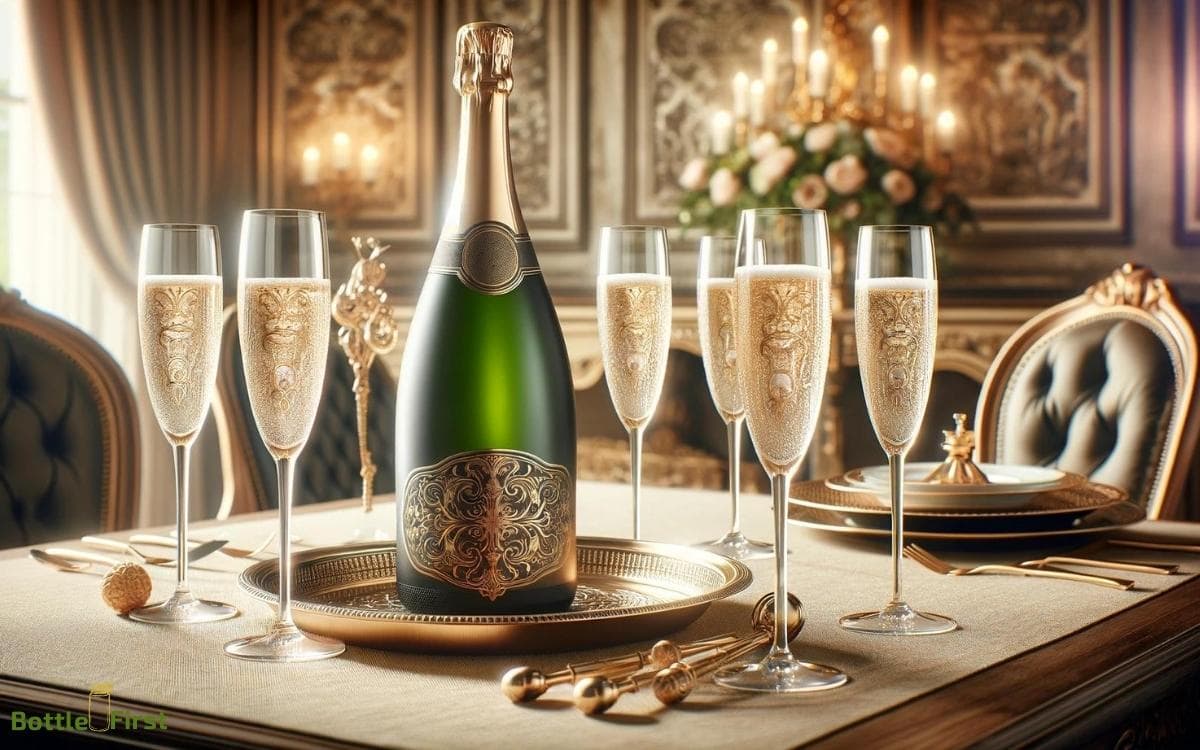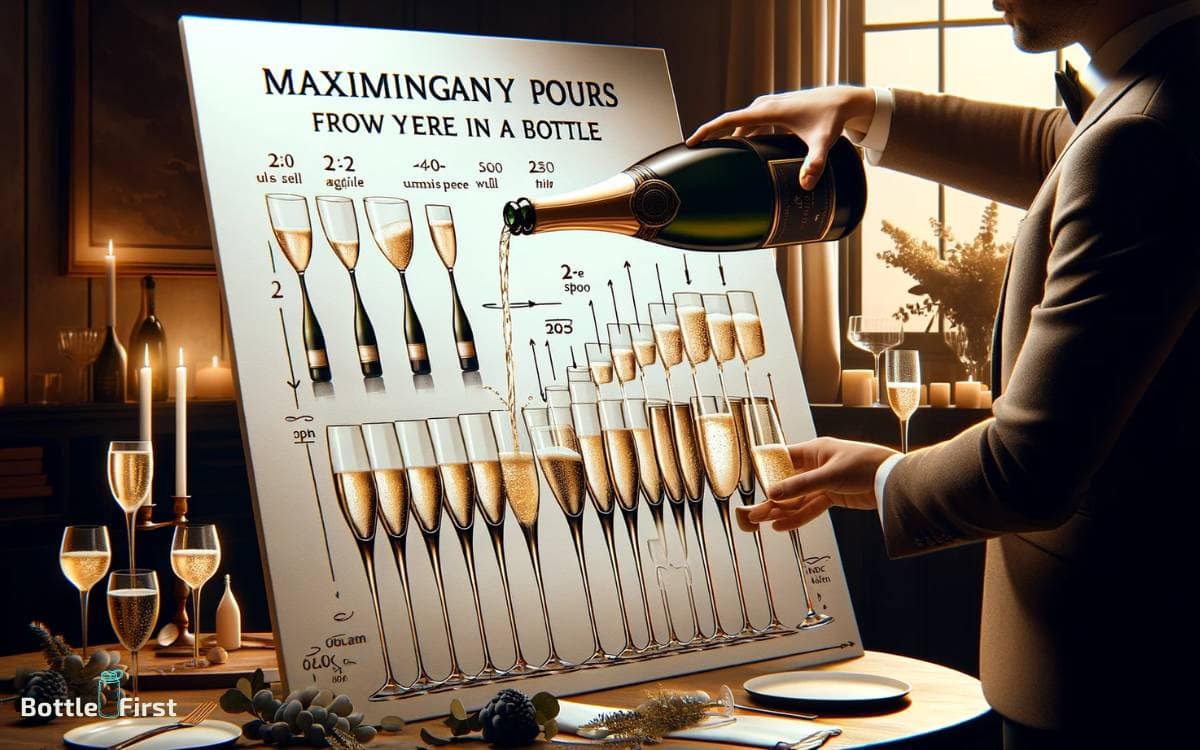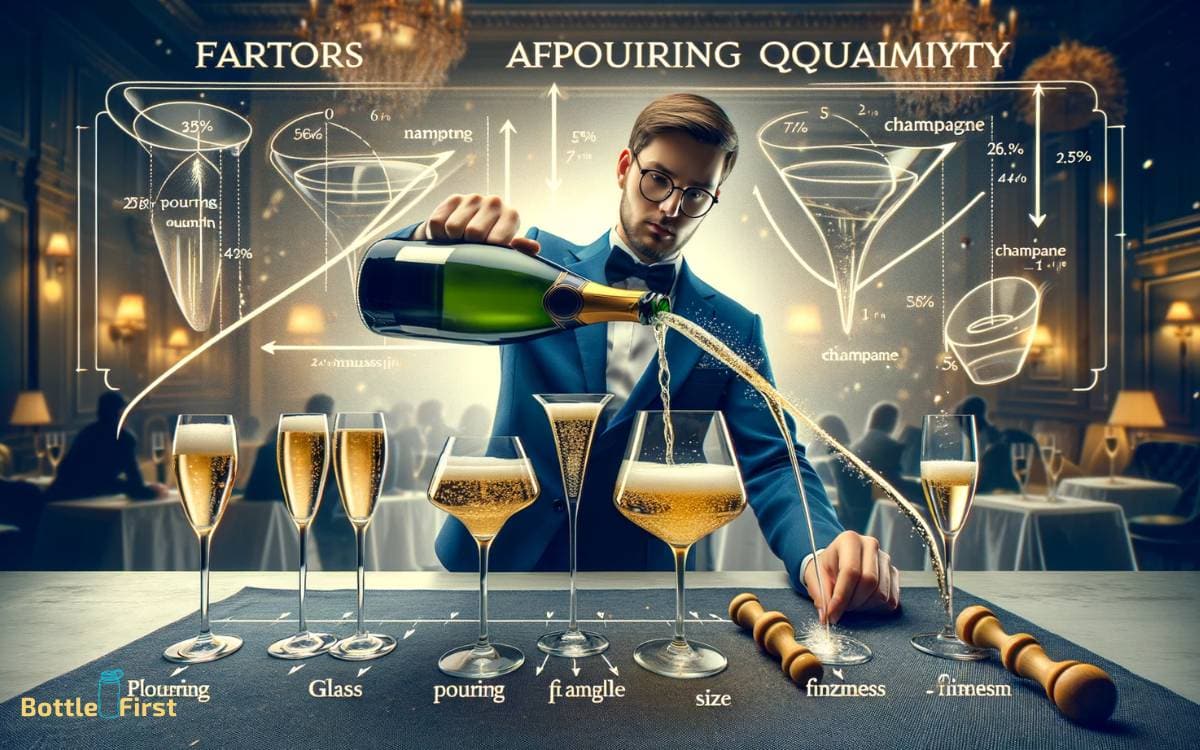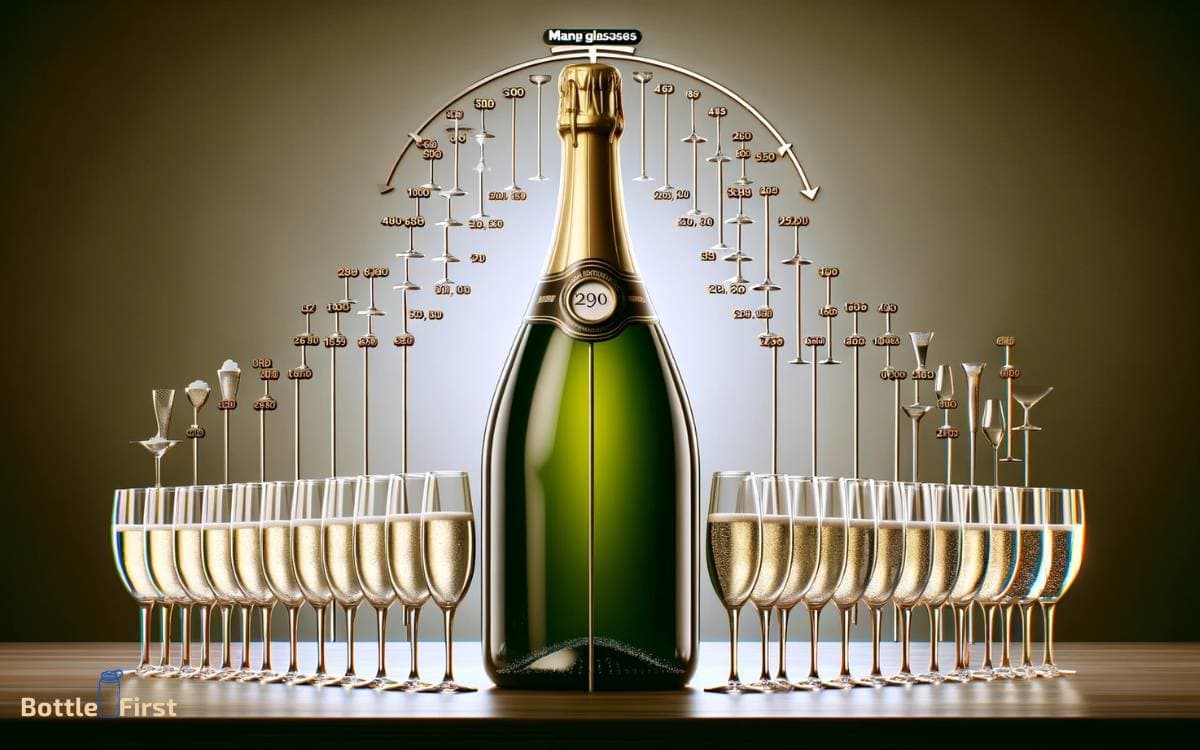How Many Glasses Are in a Champagne Bottle? Explained!
A standard champagne bottle contains 750 milliliters of champagne, which typically serves about 5 to 6 glasses, assuming a standard serving size of 125 to 150 milliliters per glass.
The traditional champagne flute is designed to hold approximately 125 to 150 milliliters, which translates to 5 to 6 servings per standard 750-milliliter bottle.
However, the actual number of glasses can vary depending on:
- The pour size: Larger pours will yield fewer glasses, while more conservative pours can yield more.
- The glass design: Some champagne glasses or flutes may hold more or less than the standard serving size.
- The event setting: In formal settings, pours might be more precise, while in casual settings, pours could be more generous.
Examples of Bottle Sizes and Servings:
- Piccolo (187.5 ml): 1-2 glasses
- Half bottle (375 ml): 2-3 glasses
- Standard bottle (750 ml): 5-6 glasses
- Magnum (1.5 L): 10-12 glasses
- Jeroboam (3 L): 20-24 glasses
Understanding champagne servings ensures a well-planned event or celebration, with ample bubbly for all your guests.
Key Takeaway
Champagne Bottle Sizes
Champagne bottle sizes vary widely, offering options to suit different occasions and group sizes.
From the standard 750ml bottle, known as a ‘750’ or ‘standard,’ to the colossal 15L Nebuchadnezzar, there’s a size for every celebration.
The Magnum, holding 1.5L, is perfect for intimate gatherings, while the Jeroboam at 3L is great for small parties. Need something for a wedding or large event? Opt for the Methuselah at 6L.
And if you’re really aiming to impress, the Salmanazar at 9L or the Balthazar at 12L will surely make a statement.
For the ultimate grand affair, the Nebuchadnezzar at 15L is a showstopper. With such a range of sizes, you can always find the perfect champagne bottle to elevate your event.
Standard Champagne Flute Capacity
Considering the various champagne bottle sizes, determining the standard champagne flute capacity can ensure you have the right amount of bubbly for your gathering.
When it comes to standard champagne flute capacity, there are a few key points to keep in mind:
- Traditional Flute: The traditional champagne flute typically holds around 6 to 10 ounces of liquid.
- Coupe Glass: A coupe glass, while not a flute, is also used for serving champagne and generally holds around 4 to 8 ounces.
- Modern Variations: Some modern champagne flutes have a larger capacity, accommodating up to 12 ounces of champagne.
- Mini Flutes: Mini champagne flutes, perfect for tastings or samplings, usually hold around 3 to 4 ounces.
- Custom Designs: With innovative designs, some champagne flutes have unique capacities that deviate from the standard sizes.
Pouring Size Considerations
When pouring champagne, it’s important to consider the size of your gathering and the purpose of the toast.
For small gatherings, you can calculate the pour based on the number of guests and the size of the glasses.
When toasting, you may want to pour slightly less to ensure that everyone’s glass can be filled for the celebratory moment.
Serving Small Gatherings
You should consider the pouring size carefully when serving small gatherings with champagne from a standard bottle.
It’s crucial to ensure that everyone gets an equal share of the bubbly without running out too quickly.
Here are some key things to keep in mind:
- Opt for smaller pours to make the bottle go further.
- Use champagne coupes or flutes with a smaller capacity to control serving sizes.
- Consider serving a champagne cocktail that includes other ingredients, allowing for smaller serving sizes.
- Encourage guests to savor and sip slowly to make the bottle last longer.
- Keep an eye on the level of champagne in the bottle to gauge how much is left and adjust pouring sizes accordingly.
Calculating Pour for Toasts
To calculate the pour for toasts, measure the champagne volume carefully to ensure everyone receives an equal serving.
A standard champagne flute holds about 6 ounces, but it’s essential to consider spillage and overflow.
For toasts, a pour of 4-5 ounces is generally recommended. With a standard 750ml bottle of champagne, you can get about 6 to 7 generous pours for toasting.
To ensure accuracy, use a measuring cup to gauge the pour size before serving. If you want to be more precise, you can use a kitchen scale to measure the champagne as you pour.
This will allow you to ensure that each guest receives an equal amount, making the toast a fair and enjoyable experience for all.
Calculation for Different Bottle Sizes
Different bottle sizes of champagne contain varying numbers of glasses based on their volume.
When determining the number of glasses in a champagne bottle, keep in mind the bottle size as it directly affects the pour for toasts.
Here are the calculations for different bottle sizes:
- Standard Bottle (750ml): Typically yields around 6 glasses
- Magnum (1.5L): Provides about 12 glasses
- Jeroboam (3L): Yields approximately 24 glasses
- Methuselah (6L): Will give you around 48 glasses
- Salmanazar (9L): Provides about 72 glasses
Understanding the pour capacity of different champagne bottle sizes allows for better planning when hosting events or celebrations.
By considering the size of the bottle, you can ensure that there’s enough champagne for all your guests to enjoy.
Tips for Maximizing Pour
When pouring champagne from a bottle, ensure that the stream is directed along the side of the glass to minimize foam.
This method helps to preserve the bubbles and aromas, enhancing the overall drinking experience.
Additionally, tilt the glass at a slight angle while pouring to further reduce foam and maintain the effervescence of the champagne.
Here are some tips to maximize your champagne pour:
Tips for Maximizing Pour
- Direct the stream along the side of the glass
- Tilt the glass at a slight angle while pouring to reduce foam
- Use a clean, dry glass to maintain carbonation
- Avoid overfilling the glass to prevent spillage
Factors Affecting Pouring Quantity
Curiously, how does the shape of the glass affect the quantity of champagne you can pour from a bottle? The glass shape plays a significant role in determining the amount of champagne you pour.
Here are some factors affecting pouring quantity:
- Bowl Shape: A wider bowl allows for more champagne to be poured, while a narrower bowl restricts the quantity.
- Tapered Rim: A glass with a tapered rim controls the flow, preventing spillage and enabling a more accurate pour.
- Height of the Glass: Taller glasses tend to hold more champagne compared to shorter ones.
- Effervescence: Glasses with a nucleation point, like a laser-etched spot at the bottom, preserve carbonation, affecting the pour.
- Temperature: Warmer champagne tends to produce more foam and thus impacts the amount poured.
Champagne Bottle to Glass Ratio
You may be wondering about the ideal champagne bottle to glass ratio for serving your guests.
Understanding the glass-to-bottle ratio can help you maximize the number of servings you can get from a single bottle of champagne.
Glass-To-Bottle Ratio Explanation
The glass-to-bottle ratio for champagne is determined by the size and shape of the bottle.
This ratio affects the number of glasses you can pour from a single bottle, influencing the overall drinking experience and serving capacity.
- Bottle Size: Larger champagne bottles, such as magnums or jeroboams, have a lower glass-to-bottle ratio due to their increased volume.
- Bottle Shape: The traditional long, slender shape of a champagne bottle allows for a higher glass-to-bottle ratio compared to wider, shorter bottle designs.
- Pouring Technique: Efficient pouring can maximize the number of glasses poured from a single bottle, impacting the glass-to-bottle ratio.
- Glass Size: The size and shape of the champagne glasses used also influence the overall glass-to-bottle ratio.
- Efficiency Consideration: Innovations in bottle and glass design aim to optimize the glass-to-bottle ratio, enhancing the drinking experience.
Maximizing Champagne Servings
Efficiently maximizing champagne servings depends on understanding the glass-to-bottle ratio and employing strategic pouring techniques.
To achieve this, consider using flutes rather than coupes, as the narrow shape of flutes helps conserve the bubbles and flavors of the champagne.
When pouring, tilt the glass at a 45-degree angle and pour slowly to prevent excessive foam formation and ensure that the champagne stays in the glass.
Aim to fill the glass to around two-thirds full to allow room for the aromas to develop.
Additionally, serving smaller 4-ounce pours allows guests to enjoy the champagne at its optimal temperature and prevents wastage.
Conclusion
So, next time you’re celebrating with a bottle of champagne, remember that the number of glasses you can pour depends on the bottle size and the size of your champagne flutes.
By understanding the pouring capacity and considering the factors that affect the pour, you can maximize the number of toasts and create a memorable experience for everyone.
Just like the sparkling bubbles in a glass, the right pour can symbolize the joy and celebration of the moment.
Cheers!








